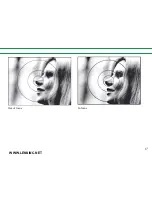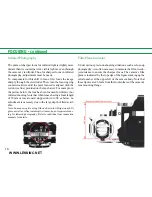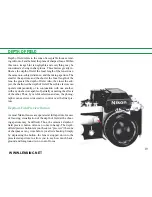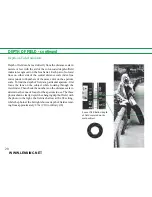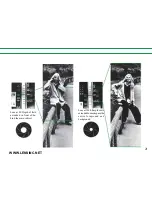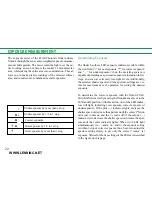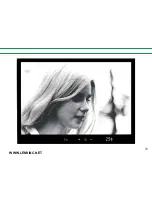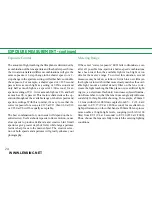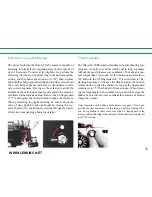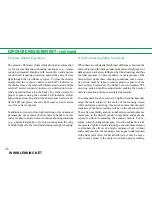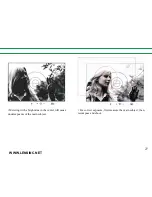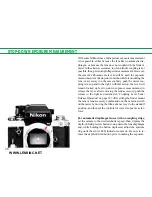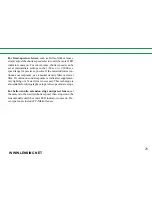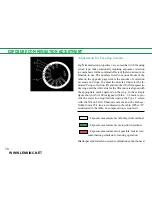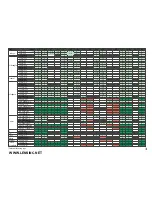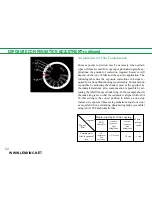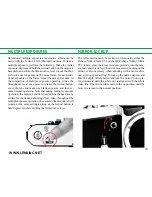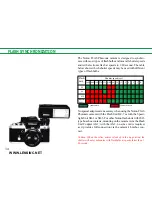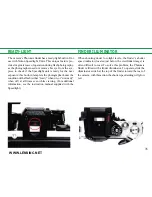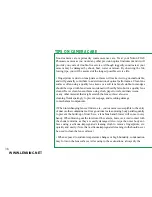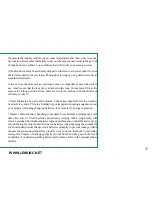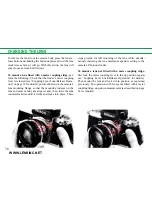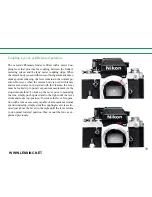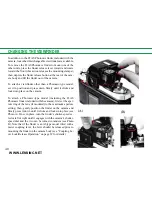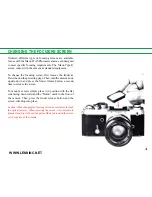
26
EXPOSURE MEASUREMENT - continued
Eyepiece Shutter Operation
The camera’s Photomic finder is fitted with an eyepiece shut-
ter for special unmanned shooting situations (e.g., remote
control, automated shooting with motor drive and aperture
control unit) requiring protection against the entry of stray
light through the viewfinder eyepiece. To close the shutter,
simply turn the eyepiece shutter control 60
°
clockwise; as
the shutter closes, the internal LEDs are deactivated and the
external “correct exposure” indicator is switched on for me-
tering operation from atop the finder. To set the camera for
proper exposure using the external LED indicator, simply
adjust the aperture ring and/or the shutter-speed selector un-
til the LED just glows; once the LED comes on, the camera
is set for correct exposure.
In addition to its use for low-light metering or for unmanned
photography, the eyepiece shutter comes in handy to ensure
correct exposure measurement in critical shooting situations
(e.g., photomicrography) or for protection against the entry
of bright light into the viewfinder during daylight shooting.
H igh-Contrast Lighting S ituations
When there are substantial brightness differences between the
main subject and the background, unimportant bright spots or
dark spots can adversely influence the finder reading, and thus
the final exposure. To prevent under- or overexposure of the
main subject under these shooting conditions, some correc-
tive action must be taken to ensure proper exposure of the
main subject. Fortunately, the finder’s center-weighted TTL
metering action simplifies adjustments, making for quicker
camera operation and more accurate final results.
To compensate for an excessively bright or dark background,
target the main subject in the center of the focusing screen
while performing metering; this action ensures that the main
emphasis of the meter reading will be on the chosen subject.
Then, after completing aperture and shutter speed adjustments,
recompose to the desired picture composition and make the
exposure without readjusting the camera controls. For ex-
ample, when shooting landscapes, it is often advisable to aim
the camera slightly downward during exposure measurement
to eliminate the effects of a bright expanse of sky; without
such compensation, the landscape may appear underexposed
in the final print. Also, for backlit subjects, it may be neces-
sary to move closer to the subject to ensure a proper reading.
WWW.LENSINC.NET
Содержание F2AS PHOTOMIC
Страница 1: ...1 INSTRUCTION MANUAL NIKON F2AS Photomic WWW LENSINC NET ...
Страница 17: ...17 Out of focus In focus WWW LENSINC NET ...
Страница 23: ...23 WWW LENSINC NET ...






